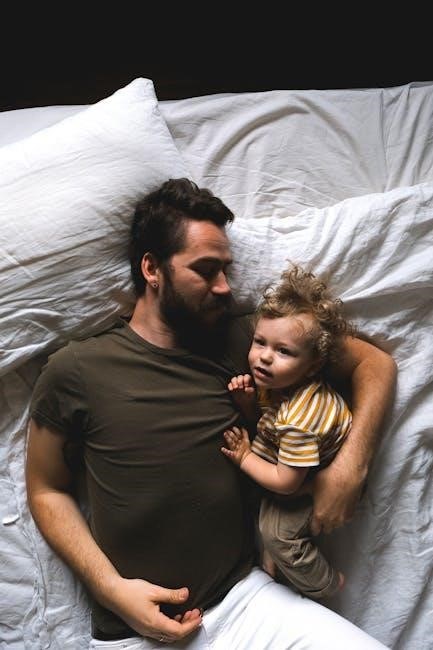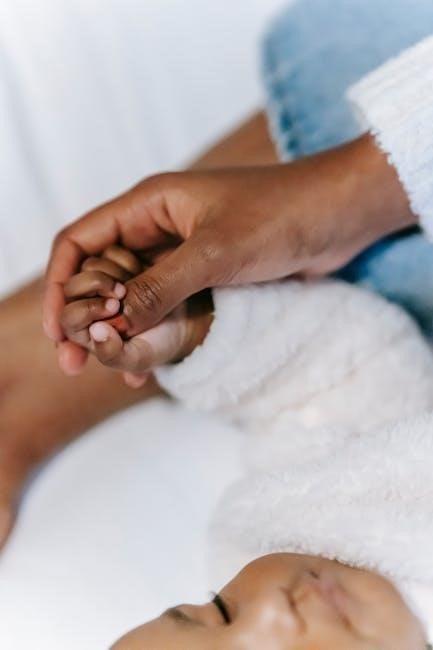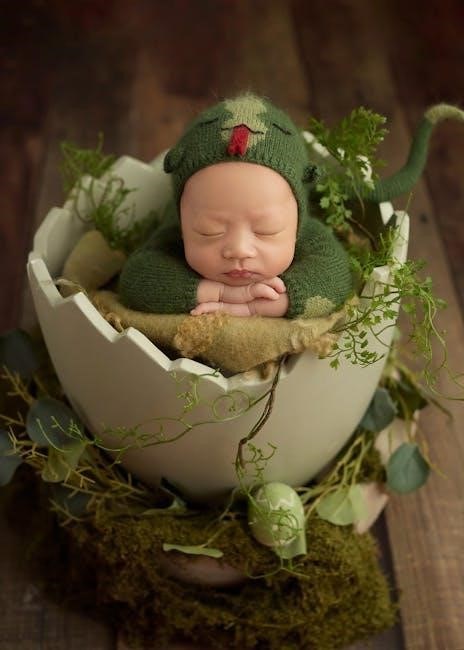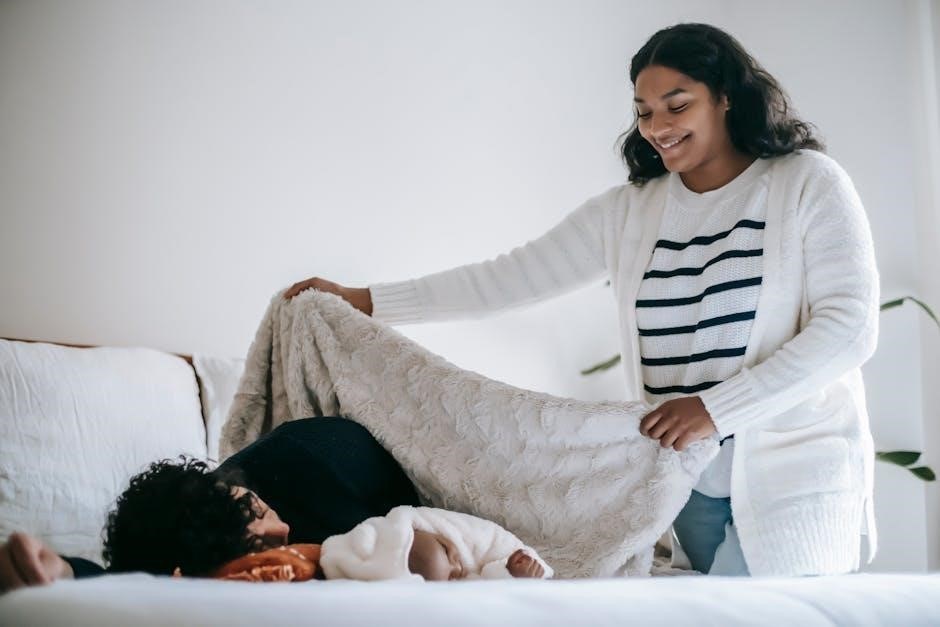Understanding TOG (Thermal Overall Grade) is essential for ensuring your baby’s comfort and safety while sleeping․ This guide explains how TOG ratings work, helping you choose the right sleep bag for your baby’s needs based on room temperature and season․
What is a TOG Rating?
A TOG (Thermal Overall Grade) rating measures the warmth and insulation of garments and bedding, such as baby sleep bags․ It indicates how well a product retains heat․ Higher TOG values mean greater warmth, making them suitable for colder environments, while lower values are better for warmer settings․ TOG ratings are essential for ensuring your baby’s comfort and safety, as they help prevent overheating or underheating․ Common TOG ratings for baby sleep bags range from 0․5 to 3․0, with 1․0 TOG being ideal for moderate temperatures․ The rating is determined by factors like material thickness, fabric type, and construction․ Understanding TOG ensures you can dress your baby appropriately for their sleep environment, promoting a comfortable and restful sleep․

Why is Understanding TOG Important for Baby Sleep?

Understanding TOG is crucial for maintaining your baby’s comfort and safety during sleep․ Babies cannot regulate their body temperature as effectively as adults, making it essential to dress them appropriately․ Overheating or underheating can lead to discomfort, restlessness, and even serious health risks like SIDS (Sudden Infant Death Syndrome)․ TOG ratings help parents choose sleep bags that align with their baby’s needs based on room temperature and season․ By selecting the correct TOG, you ensure your baby stays at a safe and comfortable temperature, promoting better sleep quality․ This knowledge also helps prevent over-layering or under-layering, which can disrupt your baby’s sleep environment․ Essentially, TOG provides a practical guide for parents to make informed decisions about their baby’s sleepwear, ensuring safety and comfort year-round․
Overview of the Guide
This comprehensive guide is designed to help parents navigate the world of baby sleep bags and TOG ratings․ It covers the basics of what TOG stands for, how it’s measured, and its relation to room temperature․ The guide also explores factors influencing TOG ratings, the range of values for baby sleep bags, and the differences between higher and lower TOG options․ Additionally, it provides practical advice on choosing the right TOG for your baby based on seasonal changes and special considerations for premature babies․ Material selection and safety standards are also discussed to ensure informed decisions․ By the end of this guide, parents will be equipped with the knowledge to create a safe and comfortable sleep environment for their baby, using TOG ratings as a trusted tool․ This guide is a must-read for all new parents seeking to understand baby sleep essentials․

Understanding TOG Basics
TOG (Thermal Overall Grade) measures the warmth and insulation of fabrics, crucial for ensuring baby sleep safety․ It helps parents choose appropriate sleepwear based on room temperature, preventing overheating or chilling․

What Does TOG Stand For?
TOG stands for Thermal Overall Grade, a standardized measure used to indicate the warmth and insulation of fabrics․ It is commonly applied to baby sleep bags and bedding to help parents understand how much heat a product retains․ The TOG rating provides a clear and reliable way to assess whether a sleep bag is suitable for different room temperatures․ Higher TOG values mean greater warmth, while lower values indicate lighter insulation․ This system ensures parents can make informed decisions about their baby’s sleep environment, promoting comfort and safety․ Understanding TOG is essential for dressing your baby appropriately for varying conditions․
How is TOG Measured?
TOG (Thermal Overall Grade) is measured using a standardized test that evaluates the thermal insulation of fabrics․ The process involves placing a specially designed “dummy” in a controlled environment to simulate a baby’s body heat․ Sensors attached to the dummy measure how well the fabric retains heat over a set period, typically several hours․ The results are then used to calculate the TOG rating, which reflects the fabric’s ability to maintain warmth without overheating;
The measurement is conducted in a laboratory setting to ensure accuracy and consistency․ The TOG value indicates how effectively the material traps warm air, with higher ratings signifying greater insulation․ This testing method provides a reliable way to assess and compare the warmth of baby sleep bags․
Relation Between TOG and Room Temperature
The TOG rating of a baby sleep bag is directly linked to the room temperature․ A higher TOG value indicates greater warmth and is suitable for colder environments, while a lower TOG is better for warmer rooms․ For example, a 1․0 TOG sleep bag is ideal for rooms maintained at a consistent temperature, typically between 64°F and 70°F (18°C and 21°C)․ As the room temperature decreases, a higher TOG rating is recommended to ensure the baby stays comfortable without overheating․
Understanding this relationship is crucial for maintaining a safe sleep environment․ A TOG rating that is too high for the room temperature can lead to overheating, while a rating that is too low may leave the baby too cold․ Always consult the manufacturer’s guidelines for specific TOG recommendations based on your baby’s room temperature․

How TOG Ratings Work
TOG ratings measure the warmth and insulation of baby sleep bags, helping parents choose the right level of comfort and safety for their baby’s sleep environment․
Factors Influencing TOG Ratings
Several factors determine the TOG rating of a baby sleep bag․ Material type and thickness are primary influences, with thicker fabrics like fleece having higher ratings․ Seasonality also plays a role, as winter bags are designed to retain more heat․ Additionally, the construction of the sleep bag, such as the presence of multiple layers or filling, can increase its TOG․ Room temperature is another critical factor, as the TOG rating must align with the baby’s sleep environment to prevent overheating or chilling․ These elements collectively ensure the sleep bag provides the appropriate level of warmth for comfort and safety․ Proper selection based on these factors is essential for a restful and secure sleep for your baby;
Range of TOG Values for Baby Sleep Bags
TOG ratings for baby sleep bags typically range from 0․5 to 3․0, indicating varying levels of warmth․ A 0․5 TOG is ideal for warmer environments and lightweight materials like cotton, while a 1․0 TOG is suitable for moderate temperatures․ Higher ratings, such as 2․0 or 2․5 TOG, are designed for colder conditions and often feature thicker, insulating fabrics․ Some sleep bags may even offer a 3․0 TOG for extreme cold․ The range allows parents to choose the appropriate warmth based on room temperature, ensuring their baby stays comfortable without overheating․ Understanding this range helps in selecting the right sleep bag for different seasons and environments, promoting safe and cozy sleep for babies․
Higher vs․ Lower TOG: What’s the Difference?
A higher TOG rating indicates a warmer sleep bag, suitable for colder environments, while a lower TOG is designed for warmer temperatures․ Higher TOG sleep bags, such as 2․5 or 3;0, are made with thicker, insulating materials to retain more heat, making them ideal for winter․ Lower TOG ratings, like 0․5 or 1․0, are lightweight and breathable, perfect for spring, summer, or well-heated rooms․ The key difference lies in the fabric’s ability to trap warmth․ Higher TOG sleep bags reduce heat loss, while lower TOG options prioritize airflow to prevent overheating․ Choosing the right TOG ensures your baby stays comfortable and safe, avoiding the risks of being too hot or cold․ This distinction is crucial for tailoring your baby’s sleep environment to their needs;

Choosing the Right TOG for Your Baby
Selecting the appropriate TOG for your baby ensures optimal comfort and safety․ Match the TOG rating to your baby’s room temperature and seasonal needs for a restful sleep․
Room Temperature Guidelines for TOG Selection
Room temperature plays a crucial role in selecting the right TOG for your baby’s sleep bag․ A general guideline is to choose a TOG rating that aligns with your baby’s room temperature․ For example, a 0․5 TOG is suitable for warmer rooms (above 75°F or 24°C), while a 1․0 TOG is ideal for standard room temperatures (68-72°F or 20-22°C)․ A 2․5 TOG is recommended for cooler environments (below 64°F or 18°C)․ Always check the manufacturer’s guide for specific TOG recommendations, as these may vary slightly․ Ensuring the room temperature is consistent and within a safe range will help your baby sleep comfortably․ Monitoring your baby’s comfort and adjusting the TOG as needed is essential for their well-being․
Seasonal TOG Recommendations
Choosing the right TOG for your baby’s sleep bag depends on the season and room temperature; In summer, a lightweight 0․5 TOG is ideal for warmer rooms (above 75°F/24°C)․ For spring and fall, a 1․0 TOG provides balanced warmth for temperatures between 68-72°F (20-22°C)․ In winter, a 2․5 TOG is recommended for cooler environments (below 64°F/18°C)․ Always consider your home’s heating and ventilation when selecting a TOG․ Layering your baby’s clothing according to the season and TOG can help maintain comfort․ Parents should also monitor room temperature and adjust the TOG as needed to ensure a safe and cozy sleep environment year-round․ Seasonal adjustments ensure your baby stays comfortable without overheating or feeling too cold․
Special Considerations for Premature Babies
Premature babies require extra care when choosing a sleep bag TOG rating due to their sensitivity to temperature․ Their thinner skin and lower body fat make them more prone to heat loss․ Always consult a healthcare provider to determine the appropriate TOG for your premature baby, as their needs may vary based on weight and medical conditions․ Generally, premature babies benefit from lower TOG ratings to avoid overheating, which can be dangerous․ Monitor their comfort closely and adjust the sleep bag as needed․ Consider using sleep bags specifically designed for premature babies, ensuring they meet safety standards and provide the right level of warmth without restricting movement․ Tailoring the TOG selection to their unique needs ensures a safe and comfortable sleep environment․

Materials and TOG Ratings
Materials significantly impact TOG ratings, with natural fibers like cotton and bamboo offering breathability, while synthetic fabrics retain more warmth․ Thicker fabrics typically have higher TOG ratings․
Common Materials Used in Sleep Bags
Baby sleep bags are made from a variety of materials, each offering unique benefits․ Cotton is the most common, known for its breathability and softness, making it ideal for warmer environments․ Bamboo fabric is another popular choice, prized for its natural temperature regulation and moisture-wicking properties․ Muslin is lightweight and breathable, often used for summer sleep bags․ Fleece-lined sleep bags provide extra warmth for colder climates, while merino wool is a premium option that balances warmth and breathability․ Each material affects the TOG rating, with thicker fabrics like fleece typically having higher TOG values․ Understanding the material can help parents select the right sleep bag for their baby’s comfort and seasonal needs․
How Material Thickness Affects TOG
Material thickness plays a crucial role in determining the TOG rating of a baby sleep bag․ Thicker fabrics, such as fleece or heavy cotton, typically have higher TOG values because they trap more heat, making them suitable for colder environments․ Conversely, thinner materials like lightweight cotton or muslin have lower TOG ratings, providing less insulation and being better suited for warmer rooms․ The thickness directly impacts the sleep bag’s ability to retain warmth, ensuring the baby stays comfortable without overheating․ This relationship between material thickness and TOG rating helps parents select the most appropriate sleep bag for their baby’s specific needs and environmental conditions․
Safety Standards for Sleep Bag Materials
Safety standards for sleep bag materials ensure that they are free from harmful chemicals and meet rigorous testing criteria․ Common materials like cotton, bamboo, and merino wool are preferred for their breathability and softness, reducing the risk of irritation or overheating․ These materials are often certified by organizations such as OEKO-TEX, which guarantees they are safe for baby skin․ Additionally, sleep bags must pass flammability tests to prevent fire hazards․ Look for materials that are lightweight and breathable to promote airflow, reducing the risk of SIDS․ Always check for certifications and follow the manufacturer’s care instructions to maintain the material’s safety and effectiveness over time․
Using the TOG Guide Practically
Apply the TOG guide by layering clothing according to room temperature and your baby’s comfort․ Monitor your baby’s temperature and adjust their sleep bag TOG as needed․
How to Layer Clothing with Sleep Bags
Layering clothing with sleep bags effectively regulates your baby’s body temperature․ Start with a lightweight base layer, such as a cotton onesie, to wick away moisture․ Add a mid-layer like a fleece sleeper if the room is cooler․ Finally, use a sleep bag with the appropriate TOG rating to match the room temperature․ Avoid over-layering, as this can lead to overheating․ Ensure the sleep bag has a zipper or easy openings for quick adjustments․ Always check the manufacturer’s guidelines for specific layering recommendations, as different materials and TOG ratings may require varying approaches․ This method ensures your baby stays comfortable and safe throughout the night․
Monitoring Your Baby’s Comfort
Monitoring your baby’s comfort is crucial to ensure they are neither too hot nor too cold while using a sleep bag․ Check for signs of overheating, such as sweating, flushed skin, or restless behavior․ Conversely, if your baby feels chilly to the touch, especially on their hands and feet, they may need additional layers․ Regularly inspect the room temperature and adjust clothing or the sleep bag’s TOG rating accordingly․ Avoid over-bundling, as this can lead to discomfort and safety risks․ Always ensure your baby’s sleep environment is safe and well-ventilated․ By paying attention to these cues, you can maintain a balanced and cozy sleep setting for your little one․
Transitioning Between TOG Ratings
Transitioning between TOG ratings ensures your baby remains comfortable as seasons change․ Start by observing shifts in room temperature and your baby’s comfort cues․ If moving to a warmer season, consider switching to a lower TOG sleep bag, while colder months may require a higher TOG․ Gradually adjust layers to help your baby acclimate to the new warmth level․ For example, you might switch from a 2․5 TOG to a 1․0 TOG when spring arrives․ Always refer to manufacturer guidelines and monitor your baby’s response to ensure a smooth transition․ This approach helps maintain a safe and cozy sleep environment throughout the year․

Frequently Asked Questions
What is TOG? How does it affect baby sleep? Can a TOG be too high or low? How do I check if my baby is too hot or cold? Are all sleep bags TOG-rated?
What Happens if the TOG is Too High or Too Low?
If the TOG rating is too high, your baby may overheat, leading to discomfort and potential safety risks․ A TOG that is too low can leave your baby too cold, especially in cooler rooms․ Overheating is a serious concern, as it can increase the risk of SIDS (Sudden Infant Death Syndrome)․ Conversely, a baby who is too cold may struggle to sleep soundly․ It’s crucial to monitor your baby’s comfort by feeling their back or chest․ If they feel hot or sweaty, the TOG may be too high․ If they feel chilly, a higher TOG sleep bag may be needed․ Always aim for a TOG that aligns with the room temperature to ensure a safe and comfortable sleep environment․
How to Check if Your Baby is Too Hot or Cold
To determine if your baby is too hot or cold, gently feel their back or chest through their clothing․ Avoid touching their hands or feet, as these can feel cool naturally․ If your baby feels sweaty or overly warm, the TOG rating may be too high for the room temperature․ Conversely, if they feel chilly or their skin is cool to the touch, the TOG may be too low․ Look for behavioral cues: a baby who is too hot may appear flushed or restless, while a cold baby might be fussier or have trouble sleeping․ Ensure the room temperature aligns with the TOG guide to maintain comfort and safety․ Adjust layers or TOG as needed, prioritizing breathability and comfort to prevent overheating or overcooling․
Do All Sleep Bags Have TOG Ratings?
Not all sleep bags have TOG ratings, but most reputable brands provide this information to help parents make informed decisions․ TOG ratings are particularly common in products designed for colder climates or seasonal use․ However, some manufacturers may not include TOG ratings, especially for lightweight or summer-specific sleep bags․ If a sleep bag does not have a TOG rating, it may still be labeled as “breathable” or “suitable for room temperature ranges․” Always check the product description or manufacturer’s guide for thermal recommendations․ If unsure, opt for sleep bags with clear TOG ratings to ensure your baby’s comfort and safety․ Remember, TOG ratings are a valuable tool for maintaining the right temperature for your baby’s sleep environment․
Understanding TOG ratings is key to ensuring your baby’s comfort and safety․ Always choose sleep bags based on room temperature and season for optimal sleep conditions․

TOG (Thermal Overall Grade) measures the warmth of baby sleep bags, ensuring your baby stays comfortable․ Higher TOG values indicate greater warmth, while lower values suit warmer rooms․ Always match the TOG rating to your room’s temperature, using manufacturer guidelines․ Seasonal adjustments are crucial, with lighter TOGs for summer and heavier ones for winter․ Material thickness and type also influence TOG ratings, with cotton being common for lower ratings․ Monitoring your baby’s comfort and adjusting layers is essential․ Remember, TOG is a tool to prevent overheating or chilling, promoting safe sleep․ By understanding and applying TOG correctly, you can create a cozy and secure environment for your baby to thrive․
Final Tips for Safe and Comfortable Sleep
Always check your baby for signs of overheating, such as sweating or flushed skin, and adjust their sleep bag or room temperature accordingly․ Ensure the sleep bag fits properly, avoiding loose fabric that could pose a safety risk․ Opt for breathable, natural materials like cotton to regulate body temperature effectively․ Regularly monitor room temperature and adjust the TOG rating of the sleep bag to match seasonal changes․ Layering lightweight clothing underneath the sleep bag can provide flexibility, but avoid over-layering․ Finally, stick to reputable brands that adhere to safety standards for TOG ratings and materials․ By following these tips, you can ensure your baby sleeps safely and comfortably year-round․
Additional Resources
For further reading, explore reputable parenting websites, baby product brands, and safety organizations․ Check manufacturer guides for detailed TOG recommendations and seasonal sleep tips․
Recommended Reading for Parents
Parents seeking deeper insights into baby sleep safety and TOG ratings can explore books like “The Baby Sleep Guide” and “Safe Sleep for Babies”․
- Online resources from reputable organizations like the American Academy of Pediatrics offer detailed guides on sleep safety․
- Websites specializing in baby care provide charts and tutorials for understanding TOG ratings․
- Blogs and forums where parents share experiences can offer practical tips for choosing the right sleep bag․
Manufacturer websites often include TOG guides tailored to their products, ensuring a perfect fit for your baby’s needs․
Where to Find More Information
For further understanding of baby sleep bag TOG ratings, parents can explore various reliable resources․ Reputable organizations like the American Academy of Pediatrics provide detailed guidelines on sleep safety and temperature regulation․ Manufacturer websites often include comprehensive TOG charts tailored to their products․ Additionally, parenting blogs, forums, and online communities share real-life experiences and tips for selecting the right sleep bag․ Websites like BabyCenter and What to Expect offer in-depth articles and FAQs․ Lastly, online marketplaces such as Amazon provide customer reviews and product descriptions that highlight TOG ratings, helping parents make informed decisions․ These resources ensure parents can find accurate and practical information to keep their baby safe and comfortable․
Leave a Reply
You must be logged in to post a comment.